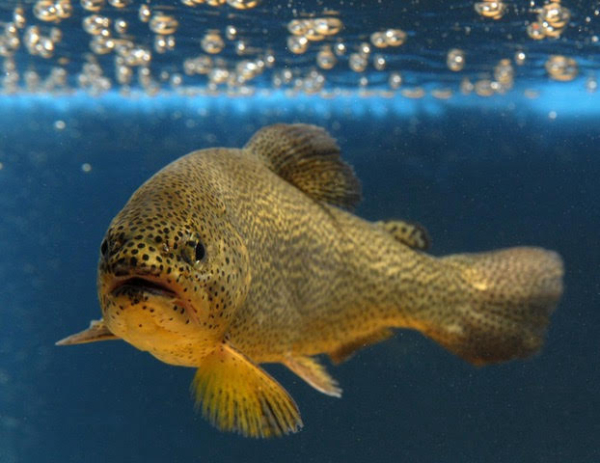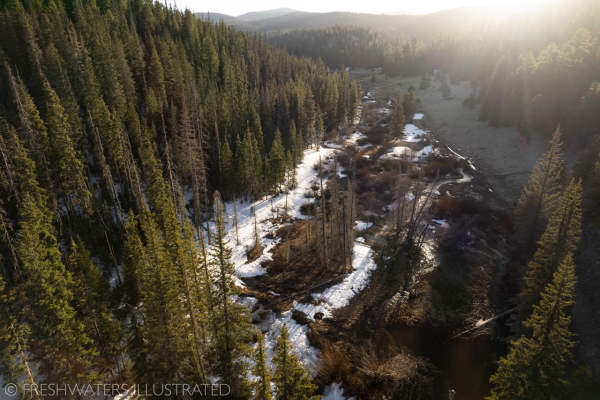USFWS Proposes Removing Apache Trout from Endangered Species List

PHOENIX — The U.S. Fish and Wildlife Service’s (USFWS) Aug. 10 announcement proposing that Apache trout be removed from the federal list of Endangered and Threatened Species is a huge win for fish and wildlife conservation. If delisted, it would be the first native trout species and gamefish to be removed from the list due to conservation efforts. (See short video clip from the Aug. 10 Apache Trout Recovery Partner Recognition event near Williams Creek National Fish Hatchery, east of McNary in eastern Arizona).
The Apache trout is Arizona’s state fish and is native exclusively to the streams in and around the White Mountains in the eastern part of the state on Tribal and public lands. It gained protection under the Endangered Species Act (ESA) in 1973, 50 years ago. The current status of Apache trout is a result of the collaborative conservation and threat reduction actions implemented by many entities, including Tribes, federal and state agencies, conservation organizations and private citizens.
“The recovery of Apache trout is a culmination of decades of hard work and the cooperation of many partners, and is truly a success story,” said Ty Gray, Director of the Arizona Game and Fish Department.
The White Mountain Apache Tribe (WMAT) was the first agency to enact protections for Apache trout beginning in the 1950s. “The Tribe’s vision and commitment to protect the species and enhance their habitat on Tribal lands, as well as the support of a broad partnership with the department and other agencies and organizations, has ensured the species’ protection and persistence,” said Gray.
The Arizona Game and Fish Department has been a long-standing partner in Apache trout recovery. The history of the department working on Apache trout recovery started decades ago, and many dedicated biologists spent parts or all of their careers working to establish Apache trout populations on U.S. Forest Service lands, primarily the Apache-Sitgreaves National Forest (ASNF). In partnership with the ASNF and others including Trout Unlimited and the U.S. Bureau of Reclamation, the department constructed barriers to protect Apache trout populations from nonnative fish and improved habitat conditions.
In the early 1960s, the department, WMAT, and USFWS entered into a controlled propagation program to raise Apache trout in hatcheries and stock them into protected streams. Beginning in 1975, the hatchery programs expanded to raise Apache trout to be stocked for recreational angling opportunities, and those programs still exist today at the department’s Tonto Creek and Silver Creek hatcheries.
When Apache trout were listed under the ESA, their range had decreased to 14 known populations in about 30 miles of stream. Today, there are 30 genetically pure populations in about 175 miles of habitat. The department currently manages 19 streams for Apache trout recovery and stocks recreational Apache trout into 14 waters, and it will continue to do so into the future.
Some recent conservation actions of the department and its partners have been:
- Opening the South Fork Little Colorado River, an Apache trout recovery stream, to catch-and-release angling on May 1, 2023. This was the fifth Apache trout recovery stream to be opened to angling and the first since 2015.
- Surveying Bear Wallow Creek, another Apache trout recovery stream, and finding more than 1,500 adult Apache trout and more than 8,000 Apache trout total. This makes it the second-largest Apache trout population in the world.
- Working with partners from the USFWS and San Carlos Apache Tribe to modify the lower artificial fish barrier on Bear Wallow Creek in 2018 to secure an additional 15.6 miles of habitat for Apache trout with funding from the National Fish and Wildlife Foundation’s Apache Trout Keystone Initiative program.
- Receiving funding from the U.S. Fish and Wildlife Service, Bipartisan Infrastructure Law – National Fish Passage Program to remove four nonfunctional barriers in the West Fork Black River watershed, reconnecting 12.5 miles of habitat to benefit Apache trout.
What does delisting mean for Apache trout?
“Decades of conservation efforts by multiple agencies and organizations have greatly improved the status of the Apache trout,” said Julie Carter, Aquatic Wildlife Branch Chief. “If delisted, the continued commitment by the recovery partners to conserve and manage the species is essential. These efforts would be implemented under the guidance of the Apache Trout Cooperative Management Plan.”
The Arizona Game and Fish Department, White Mountain Apache Tribe, Apaches-Sitgreaves National Forest, and Trout Unlimited signed onto the Apache Trout Cooperative Management Plan (CMP) in 2021. It outlines the management actions and step-down activities needed to achieve recovery and provide for long-term management if the Apache trout is delisted.
The USFWS delisting proposal was preceded by a 5-year review and 2021 species status assessment, which included the best available scientific information. The assessment evaluated the species’ current needs, condition, and threats, in addition to modeling future scenarios. The most recent 5-year review, published Aug. 23, 2022, recommended delisting this species due to recovery. More information about 5-year status reviews is available on the USFWS website.
Comments on the proposed delisting must be received within 60 days of its Aug. 10 publication in the Federal Register. Information on how to submit comments is available at www.regulations.gov by searching under docket number FWS-R2-ES-2022-0115.
Frequently asked questions for the proposed delisting can be found on the USFWS website here.






